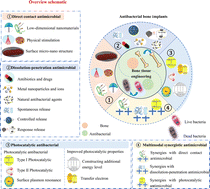Construction of antibacterial bone implants and their application in bone regeneration
Abstract
Bacterial infection represents a prevalent challenge during the bone repair process, often resulting in implant failure. However, the extensive use of antibiotics has limited local antibacterial effects at the infection site and is prone to side effects. In order to address the issue of bacterial infection during the transplantation of bone implants, four types of bone scaffold implants with long-term antimicrobial functionality have been constructed, including direct contact antimicrobial scaffold, dissolution–penetration antimicrobial scaffold, photocatalytic antimicrobial scaffold, and multimodal synergistic antimicrobial scaffold. The direct contact antimicrobial scaffold involves the physical penetration or disruption of bacterial cell membranes by the scaffold surface or hindrance of bacterial adhesion through surface charge, microstructure, and other factors. The dissolution–penetration antimicrobial scaffold releases antimicrobial substances from the scaffold's interior through degradation and other means to achieve local antimicrobial effects. The photocatalytic antimicrobial scaffold utilizes the absorption of light to generate reactive oxygen species (ROS) with enhanced chemical reactivity for antimicrobial activity. ROS can cause damage to bacterial cell membranes, deoxyribonucleic acid (DNA), proteins, and other components. The multimodal synergistic antimicrobial scaffold involves the combined use of multiple antimicrobial methods to achieve synergistic effects and effectively overcome the limitations of individual antimicrobial approaches. Additionally, the biocompatibility issues of the antimicrobial bone scaffold are also discussed, including in vitro cell adhesion, proliferation, and osteogenic differentiation, as well as in vivo bone repair and vascularization. Finally, the challenges and prospects of antimicrobial bone implants are summarized. The development of antimicrobial bone implants can provide effective solutions to bacterial infection issues in bone defect repair in the foreseeable future.

- This article is part of the themed collection: Recent Review Articles


 Please wait while we load your content...
Please wait while we load your content...